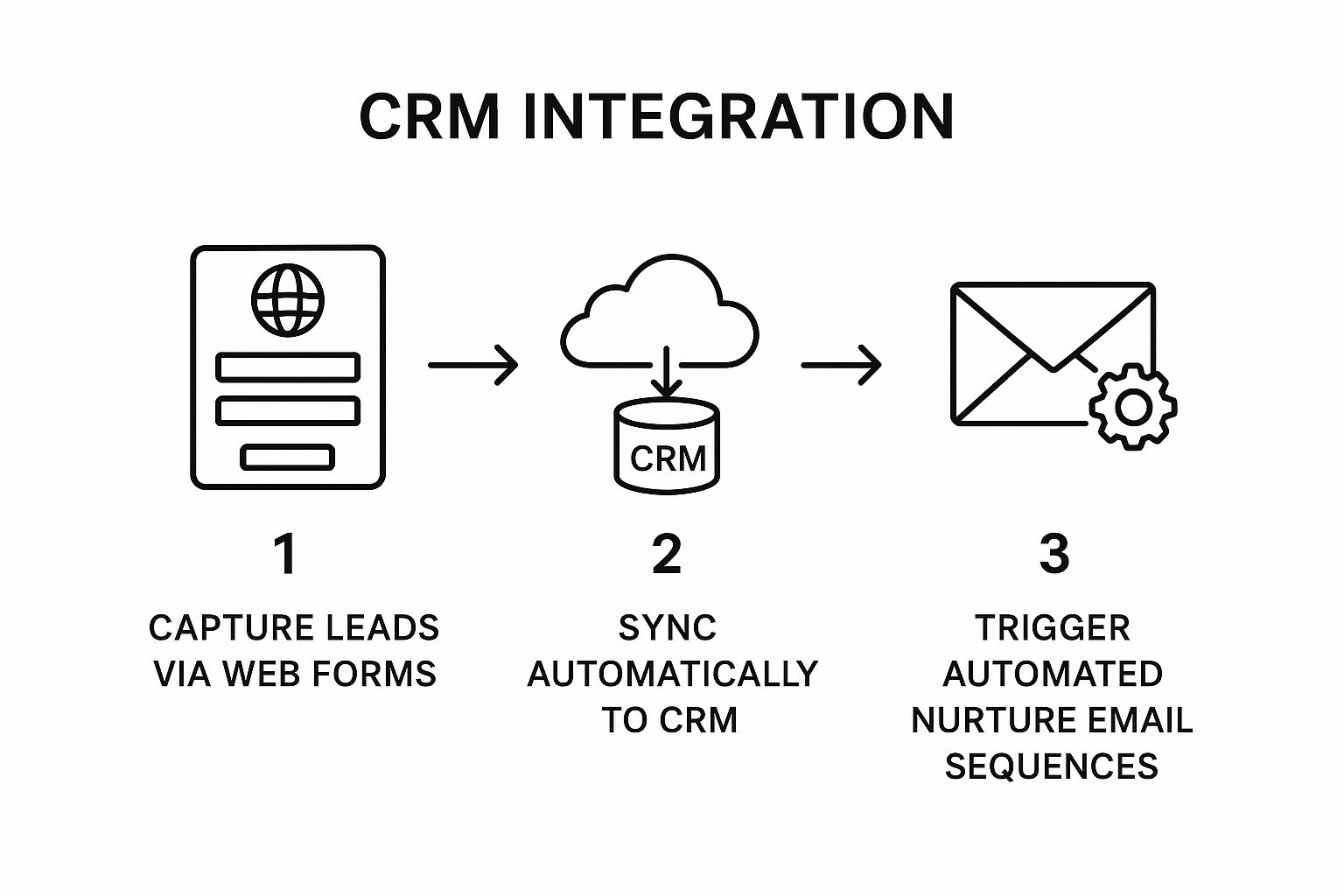To truly automate lead generation, you need to build a system that captures, qualifies, and nurtures prospects without you having to manually do everything. It’s all about using a smart stack of tools that work together to find interested buyers, figure out how engaged they are, and then deliver personalized outreach automatically.
The goal here is to stop the sporadic, one-off prospecting and move to a consistent, data-driven workflow that actually puts sales-ready conversations on the calendar.
Your Blueprint for an Automated Lead Generation System
Let's be honest, ditching the manual prospecting grind isn't just about saving a few hours. It’s about building a predictable engine that fuels your business growth. Imagine a system humming along 24/7, finding, engaging, and qualifying your ideal customers—even while you sleep. That’s the real power of a well-designed automated lead gen workflow.
A modern B2B company can absolutely shift from inconsistent efforts to a smooth, data-driven process. The core idea is to create a high-level map that guides every action, making sure all the pieces of your tech stack are talking to each other.
This isn’t about blasting out spammy, robotic messages. It's about using technology to deliver the right message to the right person at the perfect time.
The Essential Components of Automation
Before we get into the nitty-gritty, you need to understand the key parts that make this machine work. A successful automated system isn't just one tool; it's an entire ecosystem of integrated software and smart strategies. Think of this as the "why" behind the strategy before we jump into the specific "how-to" steps.
Here are the main pillars of the system:
- Lead Capture and Intent Data: This is your top-of-funnel. It’s all about using tools to spot companies and people who are actively researching solutions just like yours. Basically, you're finding prospects who have already raised their hands.
- Lead Enrichment and Scoring: Once you've captured a lead, you need to know if they're a good fit. Enrichment tools automatically pull in valuable data (like company size or job title), while scoring systems rank leads based on how much they interact with you and whether they fit your ideal customer profile.
- Automated Nurturing Sequences: This is the heart of the engine. Here, you'll deploy smart, multi-channel outreach campaigns—usually a mix of email and social media touchpoints—to build relationships and educate prospects over time.
- CRM Integration and Sales Handoff: Finally, the whole system needs to seamlessly pass the hottest, most qualified leads straight to your sales team. This simple step ensures no opportunities fall through the cracks and lets salespeople focus on what they do best: closing deals, not hunting for them.
By connecting these components, you transform cold contacts into warm, sales-ready conversations. The entire process becomes a feedback loop where data from each stage informs and improves the others.
This structured approach is what separates truly effective automation from simple, one-off campaigns. If you're looking for a deeper dive into the specifics, our complete guide on how to automate lead generation offers a detailed walkthrough of each phase.
Next up, we’ll explore the exact tools you need to build this powerful system.
Choosing the Right Tech for Your Automation Stack

Your automation engine is only as strong as the tools you plug into it. Picking the right software isn't just about ticking off a list of features; it's about building a cohesive tech stack where every piece talks to the others seamlessly. A disjointed system just creates data silos and more manual work, which defeats the whole purpose.
Let's get past the generic recommendations and talk about how to assemble a practical, powerful stack. Think of it like building a championship team—each player has a specific, crucial role, but they all communicate flawlessly to win the game.
The real goal here is to lay a scalable foundation that fits your budget and prevents those painful "rip-and-replace" projects later on. Making smart choices now is how you build a system that actually works for you, not against you.
The Central Hub: Your CRM
At the very core of any automated sales or marketing system is your Customer Relationship Management (CRM) platform. This is your command center. It has to be the single source of truth for every bit of prospect and customer data. Every interaction, every email open, every lead score—it all lives here.
A classic mistake is treating the CRM like a glorified digital rolodex. That's selling it way short. You need to think of it as the brain of your entire operation.
For instance, a CRM like HubSpot can automatically log sales calls, track a lead's visits to your pricing page, and update their status the moment they take a key action. This ensures that when a lead finally gets passed to a sales rep, that rep has a complete, chronological history of every single touchpoint. This isn't just a nice-to-have; it's absolutely essential for a personalized, effective follow-up.
The Engine: Your Marketing and Sales Automation Platform
If the CRM is the brain, your automation platform is the engine that brings your campaigns to life. This is the tool that does the heavy lifting: sending your carefully crafted email sequences, nurturing leads over time, and even handling outreach across different channels.
This could be a platform like Mailchimp or our very own Salesloop.io. These tools let you build workflows that run on triggers. For example, a new lead from the "SaaS" industry gets added to your CRM. This can instantly trigger a tailored email sequence you wrote specifically to address the unique pain points of SaaS companies.
The real power, though, is in the integration. When your automation platform and CRM are in perfect sync, data flows both ways. An email opened in your outreach tool updates the contact record in HubSpot. That simple action might bump up the lead's score, moving them one step closer to being sales-ready without anyone on your team lifting a finger.
The Intelligence: Your Data Enrichment Tools
So, how do you make sure the leads you're feeding into this well-oiled machine are actually high-quality? That's where data enrichment tools come into play. These platforms take a small piece of information, like just an email address, and flesh it out with incredibly valuable data points.
Here’s how that looks in the real world:
- A prospect downloads an ebook from your site, giving you only their name and work email.
- An enrichment tool like Apollo.io or Leadfeeder gets to work, automatically scouring the web to find their job title, company name, company size, and maybe even recent funding news.
- All this new, enriched data is pushed directly into their contact record in your CRM.
Suddenly, your automation platform has everything it needs to segment leads with surgical precision. You can now create entirely separate nurturing tracks for VPs at enterprise companies versus managers at early-stage startups—all happening automatically in the background. This is the secret to making your automated outreach feel surprisingly personal and relevant.
Using Intent Data to Target High-Value Prospects

Automation without the right audience is like sending party invitations to the wrong address—it’s a lot of effort with zero results. To make your automation actually work, you need to start by targeting prospects who are already showing real interest. This is how you stop chasing cold leads and start engaging genuinely interested buyers.
The secret ingredient here is intent data. Think of it as the collection of digital footprints people leave behind that signal they're in the market to buy. This isn't just about demographics; it's about behavior. It's the difference between knowing a company is in the tech industry and knowing someone from that company just binged three of your competitor's case studies.
Focusing on these behavioral signals is absolutely critical. While a company might generate an average of 1,877 leads every month, a staggering 97% of prospects completely ignore cold calls. This just screams for a smarter approach, one that targets people who are already listening.
Pinpointing Active Buyers with Behavioral Triggers
So, how do you actually capture and use these digital footprints? Intent data isn't some abstract concept; it comes from tangible actions you can track and interpret. The goal is to shift from a spray-and-pray, volume-based game to a precision-driven strategy.
This means getting laser-focused on the specific activities that signal a prospect is actively in a buying cycle. Even better, you can automate the monitoring of these triggers to build hyper-specific audience segments for your outreach.
Here are a few real-world examples of intent signals I always watch for:
- High-Value Content Downloads: Someone grabbing a "Pricing Guide" or an "Implementation Checklist" is screaming intent. It’s a world away from someone who just downloaded a generic "Intro to Our Industry" ebook.
- Competitor Website Visits: Certain tools can flag when employees from your target accounts are snooping around your main competitors' websites. That's a classic sign they're in comparison-shopping mode.
- Third-Party Review Site Activity: Keeping an eye on which companies are reading reviews about your product category on sites like G2 or Capterra is a goldmine. These are powerful buying signals.
- Job Posting Analysis: If a company posts a job for a "Marketing Automation Specialist," it's a safe bet they're in the market for marketing automation software.
By zeroing in on these high-intent actions, you make sure every automated message you send is timely and incredibly relevant. You're no longer interrupting their day; you're joining a conversation they already started.
Building Hyper-Specific Audience Segments
Once you start collecting this data, the real magic happens with segmentation. Instead of one massive, generic outreach list, you can build dynamic segments based on very specific behaviors. These super-focused groups are the bedrock of effective B2B sales lead generation.
For instance, you could spin up an automated workflow that only targets prospects who recently visited two of your competitors and downloaded a specific case study from your site.
The messaging for this group would be completely different from one targeting prospects who only showed mild interest in your blog content. This level of precision is what makes your automation feel personal, and it's what drives significantly higher engagement.
With your tech stack sorted and your ideal customer profile locked in, it's time for the fun part: building the machine that actually goes out and talks to people.
The goal here isn't to just blast generic messages into the void. We're aiming to build smart, multi-channel sequences that feel personal and genuinely helpful. A solid workflow doesn't just poke a prospect; it guides them on a journey.
This means thinking beyond just email. A truly effective automated workflow weaves together different touchpoints, like an email followed by a LinkedIn connection request a few days later. This approach creates a much more natural and memorable experience because you're showing up where your prospects actually spend their time.
Crafting Messages That Actually Connect
The secret to staying out of the spam folder is all about personalization at scale. This is where dynamic content fields come into play. These are basically just placeholders in your message templates that automatically pull in specific data from your CRM or lead list.
So, instead of a cringey "Hi there," you can greet them by name, mention their company, reference their job title, or even bring up a specific challenge common to their industry. It's a game-changer. Think about it from their side—an email that mentions a recent company achievement or a pain point you know they have is infinitely more likely to get a reply than a generic, one-size-fits-all pitch. That level of detail makes it feel like you wrote it just for them.
Here's a great visual of how a simple, yet powerful, lead capture and nurturing flow can work.

As you can see, the real magic happens when your website, CRM, and email platform are all talking to each other seamlessly. That's the foundation of killer automation.
Introducing Automated Lead Scoring
Okay, so the messages are going out. But how do you tell the hot leads from the "just browsing" crowd? This is where lead scoring becomes your secret weapon.
Lead scoring is a system you set up to automatically assign points to prospects based on who they are and what they do. It’s a simple but incredibly effective way to gauge interest.
For instance, a prospect might earn points like this:
- +5 points for opening one of your emails.
- +10 points for clicking a link to a case study.
- +25 points for checking out your pricing page.
- +50 points for hitting the "Request a Demo" button.
This point system works silently in the background, automatically qualifying leads. It lets your sales team stop guessing and focus their time only on the prospects who have clearly raised their hand and shown real buying intent. It's the ultimate efficiency hack for prioritizing follow-up.
For a deeper dive into setting up these kinds of intelligent sequences, checking out a guide on Mastering Marketing Workflow Automation can give you some fantastic, practical frameworks to follow. This is how you build a system that not only saves a ton of time but also leads to much higher-quality conversations and, ultimately, more deals.
Optimizing Your System with A/B Testing and Data

Getting your automated workflows live isn't the finish line; it's just the starting gun. A classic mistake I see all the time is the "set it and forget it" mindset. The real magic happens when you treat your automation system not as a static tool, but as a living engine that constantly learns and gets better with every interaction. This is how you go from just doing things faster to doing them smarter.
Think of it as creating a powerful feedback loop. Every single email you send, every link that gets clicked, and every reply you receive is a valuable piece of data. Your job is to grab these signals and use them to sharpen your approach, making your system more effective over time. This continuous cycle of improvement is what turns a decent system into an unstoppable lead-gen machine.
The Critical Role of Speed-to-Lead
One of the most powerful places to start optimizing is your follow-up speed. The whole idea of speed-to-lead boils down to one simple question: how fast does your team or system respond when a new prospect shows interest? In a crowded market, minutes can make all the difference. The first person to respond usually wins the conversation.
This is where automation gives you a massive, almost unfair, advantage. We've seen firms that put instant follow-up strategies in place get absolutely wild results. Some have reported a 300% increase in qualified meetings booked, simply by being the quickest on the draw. It makes sense when you learn that roughly half of all leads end up going to the very first business that replies. That's a pretty compelling reason to make instant response a top priority.
A Practical Framework for A/B Testing
Beyond just being fast, you have to constantly test the content of your outreach. A/B testing, or split testing, is just a fancy way of saying you compare two different versions of something to see which one performs better. It's how you stop guessing and start knowing what actually resonates with your ideal customers.
Don't just tinker with tiny details; test anything and everything that could make a difference. The goal is to pinpoint the exact variables that move the needle on your most important metrics, like reply rates and meetings booked.
Here are a few key elements I always recommend testing in your automated sequences:
- Email Subject Lines: Pit a direct, benefit-focused subject line against a more mysterious, curiosity-driven one. You might be surprised what wins.
- Calls-to-Action (CTAs): Test something like "Book a Demo" against a softer ask like "See a 5-Minute Overview." The words you choose can dramatically change a prospect's willingness to take the next step.
- Entire Nurturing Pathways: See what happens when you run a simple 3-step, email-only sequence against a more complex 5-step, multi-channel sequence that also includes LinkedIn touchpoints.
By constantly testing, you let the data—not your assumptions—drive your strategy. This data-backed approach is what steadily improves your lead quality and maximizes the return on every dollar and hour you invest in automation.
For a more detailed look at the mechanics of putting these campaigns together, our guide to sales outreach automation lays out some really practical frameworks. It's all about building a system that doesn't just run on its own but actively improves itself with every single interaction. This methodical process ensures your lead generation efforts become more efficient and more profitable over the long haul.
Common Questions About Lead Generation Automation
Jumping into automation for the first time always stirs up a few questions. That's perfectly normal. It’s a big shift in how you operate, so let's tackle some of the most common sticking points right now to clear the air before you dive in.
Getting these things ironed out from the get-go will give you the confidence you need to really commit to your new system.
How Much Does It Really Cost to Automate?
This is usually the first question on everyone's mind. There’s a common misconception that you need a massive, enterprise-level budget to even get started, but that’s just not the case anymore.
The cost can swing wildly, from under $100 a month for a couple of basic tools to several thousand for a full-blown enterprise suite. The trick is to start small and build a stack that can scale with you.
For most small or medium-sized businesses, a solid starting point is a good CRM with some automation features (like a HubSpot Starter plan) paired with a dedicated outreach tool. This setup usually lands you in the $150 to $500 monthly range, giving you serious firepower without torching your budget.
Can I Automate Without Sounding Like a Robot?
Absolutely. In fact, you must if you want any of this to work. The fear of coming across as spammy or robotic is completely valid, but it's also completely avoidable.
The secret sauce is personalization at scale. Good automation isn't about firing off generic blasts to hundreds of people. It’s about automating the delivery of a message that still feels human and one-to-one.
You do this by leaning on the data you have. Segment your audience into tight, specific groups and use dynamic fields to pull in personal details—like their first name, company, or a challenge specific to their industry.
The best automated outreach focuses on delivering real value, not a sales pitch. Share a helpful resource, a relevant insight, or a compelling case study. It turns an interruption into a welcome conversation.
What Is the Most Important Metric to Track?
It’s easy to get lost in a sea of metrics. Open rates and click-through rates are fine for checking the pulse of a campaign, but they don't really tell you if it's working.
The one metric that truly matters is your number of Sales Qualified Leads (SQLs). Or, even better, the number of Meetings Booked.
This is the bottom line. It cuts through all the noise and answers the only question that really counts: is this system generating real, valuable conversations for my sales team? Everything else is just a supporting character.
Ready to build an automated system that books meetings for you? Salesloop.io provides the multichannel outreach platform you need to turn intent data into sales-ready conversations, all on autopilot. Start scaling your outreach today.





